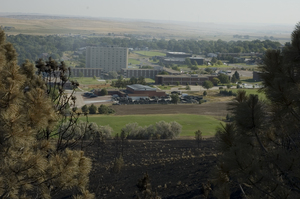Rains would be best antidote for burned areas

Gentle rains, of course, would be the best antidote for the range grasses that were burned by the wildfires that swept through thousands of acres in the Pine Ridge area of Dawes and Sioux counties in late July and early August.
“Naturally, the grasses won’t bounce back until we get some rain,” said Dr. Chuck Butterfield, head of the range management program at Chadron State College. “But if we get some rain and snow this fall and winter, we’ll see a mantel of green out in the pastures again, and initially the grass will be of higher quality than in un-burnt areas, because a cow will be getting a mouth full of just green grass, not a mix of new growth and old growth.”
Butterfield said native grasses are “used to fire,” even if it hasn’t occurred in many years as was the case in much of the area that was burned this summer. He said they will recover, depending on how soon and how much moisture is received. He added that it will be important that the new grass, when it develops, isn’t overgrazed.
Also, in some of the areas that burned extra hot, Butterfield there is nothing much left to come back, and these areas will require some intensive intervention to be productive again.
“If all the grass was burned, it would be good if that pasture could lay idle for an entire grazing season,” Butterfield noted. “I realize that may not be economically feasible for most of the ranchers, but everyone will have to make sure the grass has a chance to get re-established and grow some before it is used as forage for livestock.
“If just a portion of the pasture was burned the producer will need to watch use in that area. Once moisture is received and the grass is growing, the burned area will serve as a magnet to the livestock and will receive the bulk of the grazing pressure”
Erosion and sedimentation are also going to be an immediate and long-term concern in these areas, Butterfield cautioned. He said producers will need to work to reduce any potential runoff from these areas until adequate cover has returned.
He said the Grizzly Gulch fire in 2001 near Deadwood, S.D., is an example of the damage that can occur when heavy rains occur following a fire.
Butterfield, who helped fight the Spotted Tail Fire and teaches a fire ecology course at Chadron State, said that he and the extension educators from Dawes, Sheridan and Sioux counties are planning to host some meetings in the near future for cattlemen and area landowners whose property was burned by the fires.
Another question many have is how many of the trees in the fires’ pathway will recover?
Don Bright, supervisor for the Nebraska National Forest, said late last week that after flying over the burned areas he is optimistic that quite a few trees survived and others that were badly damaged will revive.
“I think there are quite a few clusters that survived,” Bright said. “I was impressed by the bright green needles that I saw on some trees. It’s a hodge-podge out there. In some patches all the trees will die. Trees that were by themselves or not in clusters have the best chances of surviving because the fire wasn’t as hot there. Tree spacing is important.”
Jim McMahill, a fire management officer for the Rocky Mountain Area of the Forest Service, said much the same thing Friday morning while speaking to a group of geography teachers who were at Chadron State College for a two-day conference.
“A lot of trees didn’t get killed. It will take a few years, but it will be a nice forest again. But since there had been about 100 years of fire prevention in these areas, the fuel load was heavy and a lot of damage occurred in places.”
McMahill said rehabilitation work on land managed by the Forest Service is already underway, particularly in areas where fire guards were dug by heavy equipment.
Rehabilitation efforts will begin on the Chadron State campus this week as well. The work will focus on erosion management, reclamation of dozer lines and cutting dangerous snags that remain on the hills where students often hike.
An educational interpretation also will be developed to explain the fire ecology of the area and natural restoration processes, Butterfield said.
Category: Campus News
